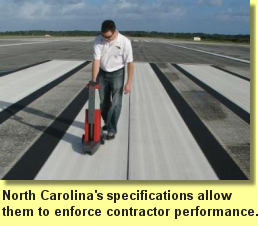 |
 |
Another First in Aviation for NCBy Donna Speidel
Performance standards (e.g. reflectivity performance) among highway projects have been implemented by the state DOT's throughout most of the nation. Sightline, among others, has been advocating performance criteria within airfield marking specifications for several years; but the response has often been that if the FAA doesn't require performance criteria, why should the state aviation organizations require them? During our research for the Airfield Marking Handbook, we were often dismayed over the poor quality markings airports paid for, installed by both in-house applicators and contractors. One of our recommendations in the Handbook was for implementation of performance standards to improve quality, longevity, and cost effectiveness of the markings. While developing the specifications for installation of airfield markings, Phil Lanier, an NCDOT airfield inspector, used the Handbook's recommendations. The team at the state level in North Carolina understands improving the standard will make their job (the inspector's) easier, will make the contractor more accountable, and will provide each airport with a better product, assuming the specifications are enforced. Using objective, quantitative measurements, inspectors will measure retro-reflectivity levels at least 24 hours subsequent to installation. If measurements meet the specified level, it passes; if it doesn't, it fails. In the case of a failure, the contractor is accountable for the discrepancy. This is standard operating procedure on the highways, but it is the first time airport markings will receive this scrutiny in a state contract. Another concern local to state airports has been algae growth obscuring markings; Mr. Lanier also included a requirement for a biocide to be manufactured into all of the paint to resist the growth of algae. Kudos to Phil Lanier, Bobby Walston, and the rest of the Department of Aviation in North Carolina for taking the lead in this effort to improve durability and performance of airfield markings. It's not required; but it's recommended. They are marking the way to higher quality and economy. |

 The North Carolina Department of Transportation, Aviation Division, has taken the lead.
Two airfield maintenance contracts have just been bid in the State of North Carolina; and included, for
the first time in a state contract, are specifications incorporating performance standards for the
installation of airfield markings.
The North Carolina Department of Transportation, Aviation Division, has taken the lead.
Two airfield maintenance contracts have just been bid in the State of North Carolina; and included, for
the first time in a state contract, are specifications incorporating performance standards for the
installation of airfield markings.